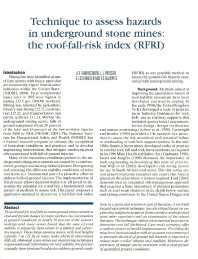Mining Publication: Technique to Assess Hazards in Underground Stone Mines: the Roof Fall Risk Index (RFRI)
Original creation date: January 2007
The potential for roof falls in underground mines remains a clear and present danger for mine workers. An investigation of ground conditions in nearly 50 percent of the nation's underground stone mines found that the state of roof stability is primarily determined in a limited and subjective manner. These large-opening mines, with roof heights typically 7 m (23 ft) or more, make physical observation difficult. Although some mines use monitoring techniques to gain additional information on roof stability, this practice is usually short term and localized to address ground conditions in a particular section or part of the mine. A roof-fall hazard-assessment technique was developed based on engineering judgment acquired from extensive underground stone mine experience and on examination of the related literature. This technique utilizes observational processes to determine roof fall likelihood. Case-study scenarios offer a realistic picture of model implementation. Providing the mine level decision-maker with an accurate assessment tool to ascertain the level of ground fall hazards is expected to reduce mine worker injuries and fatalities. Moreover, the presences of danger can be overcome with a clear picture of quantified ground conditions.
Authors: AT Iannacchione, LJ Prosser, GS Esterhuizen, TS Bajpayee
See Also
- Assessing Roof Fall Hazards for Underground Stone Mines: A Proposed Methodology
- A Computer Software Program that Estimates Air Quantity Requirements in Large Opening Stone Mines
- Diagnosing and Controlling Moisture-Sensitive Roof in Coal Mines
- The Effects of Water Emulsified Fuel on Diesel Particulate Matter Concentrations in Underground Mines
- Optimizing Secondary Roof Support with the NIOSH Support Technology Optimization Program (STOP)
- Pillar and Roof Span Design in Stone Mines
- Preventing Injuries Caused by Unrecognized Stone Mine Roof Beam Failures With a Pro-Active Roof Control Plan
- Report on Early Strength Performance of Modern Day Weak Rock Mass Shotcrete Mixes
- Roof and Rib Hazard Assessment for Underground Stone Mines
- Technology News 520 - A Method to Characterize Risk Associated With Mine Roof Conditions
- Content source: National Institute for Occupational Safety and Health, Mining Program


 ShareCompartir
ShareCompartir
